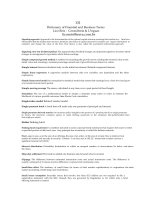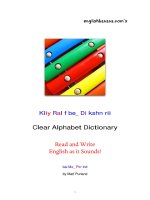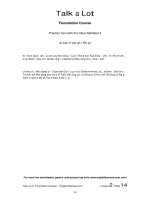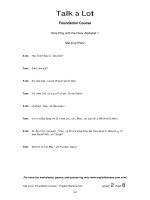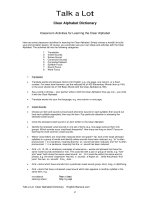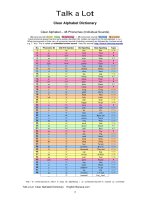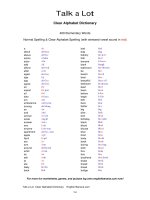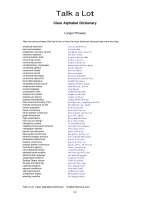14 clear alphabet dictionary
Bạn đang xem bản rút gọn của tài liệu. Xem và tải ngay bản đầy đủ của tài liệu tại đây (8.36 MB, 229 trang )
englishbanana.com’s
Kliy Ral f be_ Di kshn rii
Clear Alphabet Dictionary
Read and Write
English as it Sounds!
bai Ma_ Per lnd
by Matt Purland
1
englishbanana.com’s
Clear Alphabet Dictionary
Read and Write
English as it Sounds!
2
English Banana.com
First published in the UK by English Banana.com 2012
Cover image © Tara Heath / Fotolia (used under licence)
Public Domain
The author and sole copyright holder of this document has donated it to the public domain. Anybody
can use this document, for commercial and non-commercial purposes.
Talk a Lot
Clear Alphabet Dictionary
Contents
Contents
Introduction
Learn the Clear Alphabet
17
18
30
41
44
Clear Alphabet Chart
Learn the Clear Alphabet with Flashcards
Rhyming Words – Vowel Sounds and Diphthongs
Learn the Sounds of English with the Clear Alphabet – Sample Lesson Plan
Clear Alphabet Test (Sample)
Clear Alphabet Dictionary
47
55
85
113
140
146
152
Classroom Activities for Learning the Clear Alphabet
Translate from Clear Alphabet to Normal Spelling
Translate from Normal Spelling to Clear Alphabet
Normal Spelling & Clear Alphabet Spelling
400 Elementary Words – Translate from Clear Alphabet to Normal Spelling
400 Elementary Words – Translate from Normal Spelling to Clear Alphabet
400 Elementary Words – Normal Spelling & Clear Alphabet Spelling
Special Topics
159
160
161
162
164
166
167
168
170
Phonetic Words in Normal English Spelling
100 Sets of Common Homophones
Minimal Pairs
Silent Letters
Hidden Sounds
Words and Phrases with Glottal Stops
Longer Phrases
Words that Look Confusing in the Clear Alphabet
Problem Sound Connections – when Clear Alphabet Looks Awkward!
Examples of Worksheets for Class Use
174
176
177
178
179
180
181
182
Practice Worksheets – Instructions
Translate Countries from the Clear Alphabet
Translate Countries into the Clear Alphabet
Find the Mixed-up Countries with the Clear Alphabet
Translate Leisure Activities from the Clear Alphabet
Translate Leisure Activities into the Clear Alphabet
Find the Mixed-up Leisure Activities with the Clear Alphabet
Translate 40 Famous People from the Clear Alphabet
Talk a Lot Clear Alphabet Dictionary
English Banana.com
9
Talk a Lot
Clear Alphabet Dictionary
Contents
Relevant Material from Talk a Lot Foundation Course
185
186
187
188
189
190
191
192
193
194
195
196
197
198
199
200
201
100 Basic Words with the Clear Alphabet
100 Basic Words – Translate from the Clear Alphabet
The 100 Most Common Words in Written English
Role Play with the Clear Alphabet 1 – Mei king Planz
Role Play with the Clear Alphabet 1 – Making Plans – Translation
Practice Text with the Clear Alphabet 1 – Hau t Mei k Nai Sku p Vtee
Practice Text with the Clear Alphabet 1 – How to Make a Nice Cup of Tea –
Translation
Practice Text with the Clear Alphabet 2 – b Gi ning t Tee Chnum bz
Practice Text with the Clear Alphabet 2 – Beginning to Teach Numbers – Translation
Practice Text with the Clear Alphabet 3 – uh kon tr Ver sh l Pin yn
Practice Text with the Clear Alphabet 3 – A Controversial Opinion – Translation
Transport – Discussion Words
Transport – Discussion Words (with the Clear Alphabet)
Transport – Discussion Words (with the IPA)
List of Common Weak Forms in Spoken English
Cut-Up Clear Alphabet Sentence – Example
Cut-Up Clear Alphabet Sentence – Blank
Relevant Material from Talk a Lot Elementary Handbook
203
210
213
217
223
225
226
227
228
229
Spelling and Sounds – Vowel Clusters
Spelling and Sounds – Common Vowel Clusters (Student’s Handout)
List of Vowel Clusters – In Alphabetical Order
Spelling and Sounds – Consonant Clusters
Spelling and Sounds – Common Consonant Clusters (Student’s Handout)
Common Suffixes and What they Indicate
Suffixes and Word Stress
Discussion Words with Suffixes in Elementary Book 2
List of Noun/Verb Homographs
Working Out Word Stress – Two-Syllable Words where the First Syllable is a Schwa
Talk a Lot Clear Alphabet Dictionary
English Banana.com
10
Talk a Lot
Clear Alphabet Dictionary
Introduction
What is this book?
Wo ti zthi Sbuuk?
The Clear Alphabet Dictionary is a tool to enable students of English to learn new phonetic
Clear Alphabet, so that they can use it confidently as a means to read, write, and understand
the sounds of English – and as a result to pronounce words and sentences better. It is a tool
that enables teachers to explain the relationship between spelling and sounds at word level,
and connected speech at sentence and text level. If you are using You Are The Course Book
method, the material in this book can be used at Stage 1 (Vocabulary) and Stage 5
(Pronunciation) of Modes 1 and 2. It could also be used with students who are studying Talk a
Lot Foundation Course.
In the first part you can learn the 48 sounds of English and their corresponding written IDs
(identifiers). For example, the vowel sound in “cheese” and “meal” is always written as ee in
the Clear Alphabet. The second part is more like a traditional dictionary, with a word list of
over two thousand common words and phrases – including all of the discussion words from
Talk a Lot Elementary Books 1-3 and Intermediate Book 1. Following this is a reduced word
list of 400 Elementary-level words, which can be used with students who are new to the Clear
Alphabet. The third part contain special topics relating to using the Clear Alphabet, including
Silent Letters, Homophones, and Hidden Sounds. The fourth part has some examples of
worksheets for use in class to learn the Clear Alphabet. The last two parts of book contain
useful related material from Talk a Lot Foundation Course and Talk a Lot Elementary
Handbook.
Wo ti zth Kliy Ral f bet?
What is the Clear Alphabet?
The Clear Alphabet is a modern phonetic English alphabet which uses the normal Roman
alphabet, rather than symbols, to show the sounds of English. Each of the 48 sounds of
English has one ID (identifier) in the Clear Alphabet, which is always written the same. (See
Clear Alphabet Chart on p.17.) This allows us to write the sounds of English, rather than the
normal spelling, which is often very different from the sounds. It also allows us to write full
sentences and whole texts which show connected speech in action – the process where
words merge together as we speak. It enables us to represent speech in written form clearly,
showing syllables, stressed syllables, features of connected speech, and other elements of
speech such as schwa sounds, glottal stops, silent letters, and hidden sounds, which are
usually missing from written texts.
Wai Bo th Ler ning th Kliy Ral f bet?
Why bother learning the Clear Alphabet?
If students and teachers learn the Clear Alphabet they will be able to:
•
Improve understanding and use of the differences between spelling and sounds in an
English word, e.g.
normal spelling:
Clear Alphabet spelling:
ask
car
Arsk
Kar
For more fun worksheets, games, and quizzes log onto englishbanana.com now!
Talk a Lot Clear Alphabet Dictionary
English Banana.com
11
Talk a Lot
Clear Alphabet Dictionary
Introduction
heart
•
•
Hart
Improve understanding and use of of pronunciation, including the use of the schwa
sound and glottal stops
normal spelling:
Clear Alphabet spelling:
appointment
uh Poyn_ mnt (schwa sound indicated by uh ; glottal stop
indicated by _ )
Improve understanding and use of connected speech – including identifying the
stressed syllables in a sentence – leading to improved listening skills through the
knowledge of how native speakers of English actually speak
Normal spelling – not representative of speech:
I don’t like living in a small flat.
Clear Alphabet spelling – showing connected speech, stressed syllables (capitalised),
schwa sounds, glottal stops, and normal punctuation.
ai Deun_ Lai Kli ving i n Smorl Flat.
How is it different from the IPA (International Phonetic Alphabet)?
Hau wi zi_ Di frn_ frm thii yai pii Yei (in t Na shnl f Ne ti Kal f bet)?
The main difference is that the Clear Alphabet uses the Roman alphabet – the normal a-z that
everybody already knows, rather than obscure symbols. This means that the Clear Alphabet
can be transmitted via a normal keyboard – by computer, tablet, or phone – without a special
font. While it is difficult (although not impossible) to create and share text in the IPA via digital
means, it is much easier to do so with the Clear Alphabet.
From Talk a Lot Foundation Course1:
[The Clear Alphabet is] a new alphabet for the English language, which is similar to
the IPA in that it enables the reader to see all the phonemes (sounds) contained in
each word. However, unlike the IPA, [the Clear Alphabet] uses the more familiar
Roman alphabet – a, b, c, etc. – and allows the reader to see the stressed syllable in
a word as well as the connections between syllables and words. Each of the 48
sounds of English has its own written ID (identifier).
e.g. the “a” sound in “cake” is always written as ei – Keik
In normal spelling this sound can be written in different ways, but with [the Clear
Alphabet] it always looks the same: ei
1
Note: in Talk a Lot Foundation Course, the Clear Alphabet is referred to as the New English Alphabet (NEA)
For more fun worksheets, games, and quizzes log onto englishbanana.com now!
Talk a Lot Clear Alphabet Dictionary
English Banana.com
12
Talk a Lot
Clear Alphabet Dictionary
Introduction
e.g. make = Meik, day = Dei, change = Cheinj, etc.
i zth Kliy Ral f be_ Be t thn thii Yai pii yei?
Is the Clear Alphabet better than the IPA?
From Talk a Lot Foundation Course:
The current IPA (International Phonetic Alphabet) was invented in the nineteenth
century by French and British linguists. The IPA can be helpful in some situations, for
example if a student takes the time to learn it they will be able to accurately
pronounce any word in the dictionary. When teaching language – and especially
pronunciation – we do need a way of representing sounds on a page, but the current
IPA is no longer fit for purpose in the Digital Age, because it cannot be easily
reproduced on a keyboard or mobile phone keypad. Just try sharing a document that
uses IPA symbols and you will see what I mean. Everybody needs to buy a new font
– which does not happen. So we need a new phonetic way of writing. Another
problem with the IPA is that students have to learn a whole new alphabet of around
fifty new characters. Students are often put off by the unfamiliar and exotic-looking
symbols that they have to learn, which only adds an extra burden for students –
especially those whose first language does not always use the Roman alphabet, e.g.
those whose first language is Arabic, Russian, Chinese, etc. They already have to
learn one new alphabet to learn English; then we try to add a second. It’s no wonder
the IPA is put on the back burner.
For example, let’s compare this earlier sentence in the Clear Alphabet with its equivalent in
the IPA:
Normal spelling:
I don’t like living in a small flat.
Clear Alphabet spelling:
ai Deun_ Lai Kli ving i n Smorl Flat.
IPA spelling:
/~fDÇÉìå\Dä~fDâäfKîfÏKfKåDëãlWäDÑäôíL=
While Clear Alphabet spelling takes some learning and getting used to, it is far easier and
more intuitive to learn than the IPA because the letters are already familiar, and has the
added bonus of showing the stressed syllables – the all-important sound spine – as well as
normal punctuation marks.
Is the Clear Alphabet a replacement for the current Roman alphabet?
i zth Kliy Ral f be t r Plei smn_ f th Ku rn_ Reu m Nal f bet?
For more fun worksheets, games, and quizzes log onto englishbanana.com now!
Talk a Lot Clear Alphabet Dictionary
English Banana.com
13
Talk a Lot
Clear Alphabet Dictionary
Introduction
In Talk a Lot Foundation Course I have argued that, yes, it could be:
We need a new written English alphabet. The old one (a, b, c, etc.) is not fit for
purpose because it doesn’t contain enough letters (especially vowel letters) to
adequately represent all of the 48 sounds of English. We cannot write phonetically –
as we speak – with this alphabet. It allows us to write words, but we speak syllable by
syllable, not word by word. It doesn’t show stressed syllables, but it is vital for us to
know which syllables are stressed. It doesn’t show the “hidden” features of spoken
English – schwas and glottal stops – but if we don’t use these features our
pronunciation will be much worse, and communication will be reduced.
The old written alphabet has 26 letters – but there are 48 sounds in English.
The old written alphabet has 5 vowel letters – but there are 23 different vowel sounds
in English.
[The Clear Alphabet] provides the remedy to both problems, because it allows us to
write phonetically, representing the sounds we make when we speak. It is a true
alphabet. It also clearly shows individual syllables, stressed syllables, schwas, and
glottal stops.
How many words are there in the dictionary – and how were they chosen?
Hau Me nii Wer dz th rin th Di kshn rii – yn Hau w thei Cheu zn?
The dictionary contains just over 2,000 common words and phrases, so it is not intended to
be an exhaustive dictionary along the lines of a major English dictionary. Also, there are no
definitions – just words in the Clear Alphabet and in normal spelling. However, the dictionary
certainly contains enough terms for anyone to be able to understand and learn how the Clear
Alphabet works and how it can be used to represent sounds in a word or sentence. The terms
were chosen from a wide range of sources, with the focus on high-frequency words:
•
•
Talk a Lot Elementary Books 1-3
Talk a Lot Intermediate Book 1
•
•
•
•
•
Oxford English Dictionary Corpus
The Dolch Basic Site Vocabulary
Top 20 Phrasal Verbs
Big Grammar Book
…Words You Must Know (series)
discussion words and sentence block verbs
discussion words, sentence block verbs, and
a selection of common idioms & slang terms
2
top 100 words in written English
3
220 frequently used words
my own list4
basic words from Essential English pages
common word list: nouns, verbs, adjectives,
function words5
2
[accessed on: 04.08.12]
[accessed on: 04.08.12]
[accessed on: 04.08.12]
5
For example: />[accessed on: 04.08.12]
3
4
For more fun worksheets, games, and quizzes log onto englishbanana.com now!
Talk a Lot Clear Alphabet Dictionary
English Banana.com
14
Talk a Lot
Clear Alphabet Dictionary
Introduction
•
•
•
Talk a Lot Foundation Course
Check It Again! (Book One)
List of 80 common functions
General notes on the dictionary:
•
•
list of pronunciation terms from the Glossary
list of grammar terms from the Glossary
my own list
Jen rl Neu_ zon th Di kshn rii
Terms are presented in British English throughout the dictionary – both in terms of
normal spelling and pronunciation
Generally, nouns have singular forms
Closing remarks
Kleu zing r Markz
This material has been trialled in classrooms – both offline and online. Thanks to everybody
who took part in those lessons!
I really hope that you find this book useful and that you are able to improve your English skills
by learning and using the Clear Alphabet. If you have any questions or comments about this
book, or anything connected with Talk a Lot or English Banana.com, I would love to hear from
you. Please feel free to contact me here:
Matt Purland
th
Ostróda, Poland, 25 August 2012
For more fun worksheets, games, and quizzes log onto englishbanana.com now!
Talk a Lot Clear Alphabet Dictionary
English Banana.com
15
Lern th Kliy Ral f bet
Learn the Clear Alphabet
16
Talk a Lot
Clear Alphabet Dictionary
Clear Alphabet 48 Phonemes (Individual Sounds)
23 vowel sounds: 8 short 5 long 10 diphthongs | 25 consonant sounds: 15 voiced 10 unvoiced
Each phoneme always has the same written identifier (ID). Letters not used from the old alphabet: c, q, x
When pronounced on their own, all consonant sounds (including unvoiced) are followed by a schwa sound,
e.g. 7. buh. This is called an embedded schwa sound. Hear the sounds: />No.
1.
2.
3.
4.
5.
6.
7.
8.
9.
10.
11.
12.
13.
14.
15.
16.
17.
18.
19.
20.
21.
22.
23.
24.
25.
26.
27.
28.
29.
30.
31.
32.
33.
34.
35.
36.
37.
38.
39.
40.
41.
42.
43.
44.
45.
46.
47.
48.
Phonemic ID
a
ai
aiy
ar
au
auw
b
ch
d
e
ee
ei
eir
er
eu
f
g
h
hh
i
ii
iy
j
k
l
m
n
ng
o
oo
or
oy
p
r
s
sh
t
th
tt
u
uh
uu
uuw
v
w
y
z
zz
_
Old IPA Symbol
LụL=
L~fL=
L~f]L=
L^WL=
L~rL=
L~r]L=
LL=
LớpL=
LầL=
LẫL=
LỏWL=
LẫfL=
Lẫ]L=
LWL=
L]rL=
LẹL=
LệL=
LĩL=
LủL=
LfL=
LỏL=
Lf]L=
LầwL=
LõL=
LọL=
LóL=
LồL=
LẽL=
LflL=
LỡWL=
LlWL=
LlfL=
LộL=
LờL=
LởL=
LpL=
LớL=
LaL=
LqL=
LắL=
L]L=
LrL=
Lr]L=
LợL=
LùL=
LL=
LũL=
LwL=
L\L=
Old Spelling
New Spelling
bat
time
hire
star
cow
power
bag
cheese
dice
leg
three
plane
pear
shirt
home
frog
glass
head
loch
dish
happy
here
jam
kit
lake
music
nurse
ring
sock
shoot
ball
toy
pig
road
snow
shop
taxi
brother
thousand
cup
arrive
pull
pure
van
week
yoghurt
zip
revision
football
Bat
Taim
Haiy
Star
Kau
Pauw
Bag
Cheez
Dais
Leg
Ttree
Plein
Peir
Shert
Heum
Frog
Glars
Hed
Lohh
Dish
Ha pii
Hiy
Jam
Kit
Leik
Myoo zik
Ners
Ring
Sok
Shoot
Borl
Toy
Pig
Reud
Sneu
Shop
Ta ksii
Bru th
Ttau znd
Kup
uh Raiv
Puul
Pyuuw
Van
Week
Yo gt
Zip
r Vi zzn
Fuu_ borl
Type
v/s
d
d
v/l
d
d
c/v
c/u
c/v
v/s
v/l
d
d
v/l
d
c/u
c/v
c/u
c/u
v/s
v/s
d
c/v
c/u
c/v
c/v
c/v
c/v
v/s
v/l
v/l
d
c/u
c/v
c/u
c/u
c/u
c/v
c/u
v/s
v/s
v/s
d
c/v
c/v
c/v
c/v
c/v
Key v = vowel sound: s = short l = long d = diphthong | c = consonant sound: v = voiced u = unvoiced
Talk a Lot Clear Alphabet Dictionary
English Banana.com
17
Talk a Lot
Clear Alphabet Dictionary
Learn the Clear Alphabet with Flashcards
Students can use the flashcards on pp.20-29 for learning and memorising the forty-eight
sounds of English with the Clear Alphabet. The aim is to know the sounds by heart, so that
they can look at any of the Clear Alphabet IDs (identifiers) on their own and say the sound
straight away.
Instructions
1. Print the pages back to back onto thin card, in the following order:
•
•
•
•
•
print pages 20 and 21 back to back
print pages 22 and 23 back to back
print pages 24 and 25 back to back
print pages 26 and 27 back to back
print pages 28 and 29 back to back
2. Cut out the cards and laminate them, if possible, for extra durability.
3. For students: use the cards to learn the sounds by quickly testing yourself in spare
minutes of the day, e.g. on the bus, at lunchtime, when you’re watching TV, etc.
4. For teachers: use the cards to test your class for a short period of time every day, just
to keep the identifiers and sounds in your students’ minds, or give a set of cards to
each student and encourage them to practise in pairs or small groups. You could use
some or all of the activities below.
Key to Abbreviations
v/s
v/l
d
c/v
c/u
= short vowel sound
= long vowel sound
= diphthong
= voiced consonant (i.e. your vocal cords vibrate when you make it; feel your throat
as you make a sound to find out whether it’s voiced or not; if it vibrates, it is voiced!)
= unvoiced consonant (your vocal cords don’t vibrate when you make this kind of
sound)
Note: it’s well worth getting students to learn the Clear Alphabet sounds with an extra layer of
detail, so that they learn the concepts above. For example, that e isn’t only a vowel sound,
but that it’s a short vowel sound; or that n isn’t only a consonant sound, but it’s a voiced
consonant sound that makes your vocal cords vibrate – and also a friendly consonant sound.
Suggested Classroom Activities
I made my own flashcards like these to learn and memorise which sound each symbol of the
IPA represented, when I was training to be an English teacher more than twelve years ago,
but there are lots of other ways in which you could use them beyond simply learning quietly at
home:
a) Put all of the cards on the table – simple side up – in front of your students. Say a
sound, and the first to find the correct card is the winner. Or, say “voiced consonant”
or “long vowel sound”, etc. (as above) and the first to find one is the winner.
Talk a Lot Clear Alphabet Dictionary
English Banana.com
18
Talk a Lot
Clear Alphabet Dictionary
Learn the Clear Alphabet with Flashcards
b) Show a card with a sound on it and students have to say a word each that includes
this sound.
c) Students have to put several of the cards in order to make a simple word, e.g. “cat” =
k
a
t
d) Or you could ask students to spell out their first name, or the make of their car, or
their first pet’s name, etc., or one (or more) of any current vocabulary word or phrase,
using the cards. You may need a few sets of cards to be able to do this.
e) Try this fun game for two students working in a pair (it could also be adapted for two
small groups battling each other). Each student has half the cards from the set. They
hold them in their hands in a (shuffled) pack so that the other student can’t see which
cards they’ve got. The first student produces the first card and their partner has ten
seconds (or five, if your group is at a good level!) to say an English word that contains
that sound. If they are correct they get the card, and put it in a separate pile from the
pack in their hands. If they are wrong, or can’t think of a word, the original student
gets to keep the card, again putting it in a separate pile. Play alternates between the
two students and continues until the students don’t have any cards left in their hands.
The winner will be the student with the most cards at the end of the game (or at the
end of an agreed period of time, e.g. fifteen minutes). A variation to make the game
harder would be to insist on two words (or more) for each sound, or to get the
students to write the words using the Clear Alphabet, as well as saying them.
f) Use the rhyming words listed on pp.30-40 to demonstrate how the same sounds in
English can be achieved with very different spelling patterns. See also the information
on Vowel Clusters (from p.203) and Consonant Clusters (from p.217) later in the
dictionary.You could make the important point that English is not a phonetic
language, and that the spelling of a word in English often bears little or no relation to
the sounds that it contains.
g) Or use the rhyming words to get students saying lots of words with the same vowel
sound out loud. You could even get them to write sentences using as many words
which have the same vowel sound in them as possible, for example:
Sound:
ee=
Sentence:
“Pete’s feet feel the need for speed each week.”
or:
Sound:
ei=
Sentence:
“Jane’s Danish mate made it plain that her place in Spain was a waste of
space.”
Why not collect together the funniest or longest sentences and make a classroom display, or
book, or better still, email them to us at English Banana.com so that we can put them on the
Talk a Lot pages! Similarly, you will doubtless find lots more new ways for using these
flashcards. If you would like to share them with other teachers and students, please do email
them to us and tell us what worked for you.
[This article was adapted from Talk a Lot Elementary Handbook.]
Talk a Lot Clear Alphabet Dictionary
English Banana.com
19
Talk a Lot
Clear Alphabet Dictionary
Simple Flashcards (Page 1 of 5)
i
a
Talk a Lot
Talk a Lot
o
uu
Talk a Lot
Talk a Lot
uh
e
Talk a Lot
Talk a Lot
ii
ee
Talk a Lot
Talk a Lot
ar
or
Talk a Lot
Talk a Lot
For more fun worksheets, games, and quizzes log onto englishbanana.com now!
Talk a Lot Clear Alphabet Dictionary
English Banana.com
20
Talk a Lot
Clear Alphabet Dictionary
Detailed Flashcards (Page 1 of 5)
a
bat
Bat
i
v/s
dish
uu
pull
Puul
Leg
v/s
sock
Ttree
v/s
arrive
Borl
v/s
uh Raiv
v/s
ii
v/l
happy
or
ball
Sok
uh
ee
three
v/s
o
e
leg
Dish
Ha pii
v/s
ar
v/l
star
Star
v/l
For more fun worksheets, games, and quizzes log onto englishbanana.com now!
Talk a Lot Clear Alphabet Dictionary
English Banana.com
21
Talk a Lot
Clear Alphabet Dictionary
Simple Flashcards (Page 2 of 5)
oo
er
Talk a Lot
Talk a Lot
u
ei=
Talk a Lot
Talk a Lot
ai
oy
Talk a Lot
Talk a Lot
eir
aiy
Talk a Lot
Talk a Lot
eu
au
Talk a Lot
Talk a Lot
For more fun worksheets, games, and quizzes log onto englishbanana.com now!
Talk a Lot Clear Alphabet Dictionary
English Banana.com
22
Talk a Lot
Clear Alphabet Dictionary
Detailed Flashcards (Page 2 of 5)
er
Shert
shirt
oo
v / l=
Shoot
shoot
ei
plane
Plein
u
d=
Kup
cup
oy
Toy
toy
Haiy
d=
Kau
Taim
time
d=
eir
d=
pear
au
cow
v / s=
ai
aiy
hire
v / l=
Peir
d=
eu
d=
home
Heum
d=
For more fun worksheets, games, and quizzes log onto englishbanana.com now!
Talk a Lot Clear Alphabet Dictionary
English Banana.com
23
Talk a Lot
Clear Alphabet Dictionary
Simple Flashcards (Page 3 of 5)
iy
uuw
Talk a Lot
Talk a Lot
auw
b
Talk a Lot
Talk a Lot
g
v
Talk a Lot
Talk a Lot
t
d
Talk a Lot
Talk a Lot
tt
th
Talk a Lot
Talk a Lot
For more fun worksheets, games, and quizzes log onto englishbanana.com now!
Talk a Lot Clear Alphabet Dictionary
English Banana.com
24
Talk a Lot
Clear Alphabet Dictionary
Detailed Flashcards (Page 3 of 5)
uuw
pure
Pyuuw
iy
d=
here
b
bag
Bag
Van
c / v=
power
c / v=
glass
d=
Dais
Bru th
Glars
c / v=
t
c / v=
taxi
th
brother
Pauw
g
d
dice
d=
auw
v
van
Hiy
Ta ksii
c / u=
tt
c / v=
thousand
Ttau znd
c / u=
For more fun worksheets, games, and quizzes log onto englishbanana.com now!
Talk a Lot Clear Alphabet Dictionary
English Banana.com
25
Talk a Lot
Clear Alphabet Dictionary
Simple Flashcards (Page 4 of 5)
p
k
Talk a Lot
Talk a Lot
s
sh
Talk a Lot
Talk a Lot
ch
h
Talk a Lot
Talk a Lot
r
w
Talk a Lot
Talk a Lot
y
m
Talk a Lot
Talk a Lot
For more fun worksheets, games, and quizzes log onto englishbanana.com now!
Talk a Lot Clear Alphabet Dictionary
English Banana.com
26
Talk a Lot
Clear Alphabet Dictionary
Detailed Flashcards (Page 4 of 5)
k
kit
Kit
p
c / u=
pig
sh
shop
Shop
Hed
c / u=
snow
Week
c / u=
cheese
c / u=
Cheez
c / u=
r
c / v=
road
m
music
Sneu
ch=
w
week
c / u=
s
h
head
Pig
Myoo zik
Reud
c / v=
y
c / v=
yoghurt
Yo gt
c / v=
For more fun worksheets, games, and quizzes log onto englishbanana.com now!
Talk a Lot Clear Alphabet Dictionary
English Banana.com
27
Talk a Lot
Clear Alphabet Dictionary
Simple Flashcards (Page 5 of 5)
n
ng
Talk a Lot
Talk a Lot
l
f
Talk a Lot
Talk a Lot
z
zz
Talk a Lot
Talk a Lot
j
hh
Talk a Lot
Talk a Lot
/'/
_
Talk a Lot
Talk a Lot
For more fun worksheets, games, and quizzes log onto englishbanana.com now!
Talk a Lot Clear Alphabet Dictionary
English Banana.com
28
Talk a Lot
Clear Alphabet Dictionary
Detailed Flashcards (Page 5 of 5)
ng
ring
Ring
n
c / v=
nurse
f
frog
Frog
c / u=
lake
r Vi zzn
Lohh
Leik
c / v=
z
c / v=
zip
hh
loch
c / v=
l
zz
revision
Ners
Zip
c / v=
j
c / u=
jam
Jam
c / v=
_
football Fuu_ borl (glottal stop)=
For more fun worksheets, games, and quizzes log onto englishbanana.com now!
Talk a Lot Clear Alphabet Dictionary
English Banana.com
29
Talk a Lot
Learn the Clear Alphabet
Rhyming Words – Vowel Sounds 1
All of the words in each group are rhyming words – they all share the same vowel sound. Notice the different
spelling patterns that we can use to make the same vowel sound. Can you think of any more words with the same
vowel sounds and spelling patterns?
i
ii
vowel sound in ‘f i sh’
vowel sound in ‘empt y’
vowel sound in ‘f ee t’
fish
dish
wish
empty
guilty
honesty
feet
meet
sheet
bid
hid
lid
did
rugby
feat
heat
neat
seat
treat
fill
hill
Jill
still
pill
bill
Bill
chill
will
kill
juicy
Lucy
pit
it
hit
nit
lit
bit
spit
wit
lovely
lily
ee
Pete
mete
smelly
jolly
chilly
frilly
Billy
really
deed
need
feed
speed
lead
knead
pretty
Betty
heal
steal
deal
hockey
jockey
peel
heel
wheel
movie
smoothie
spin
chin
win
tin
gin
speak
leak
limb
dream
team
steam
peek
cheek
list
mist
seen
been
missed
kissed
hissed
clean
For more fun worksheets, games and quizzes log onto www.englishbanana.com now!
Talk a Lot Clear Alphabet Dictionary
English Banana.com
30
18.27

